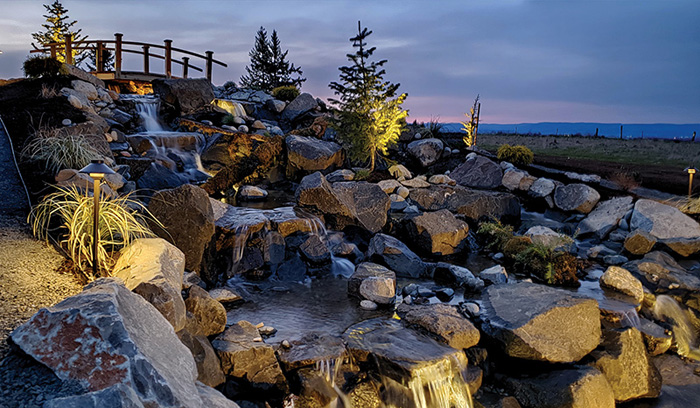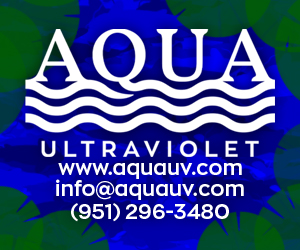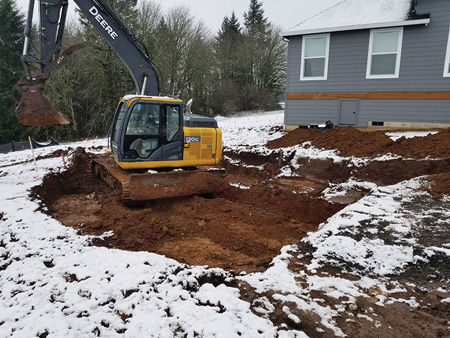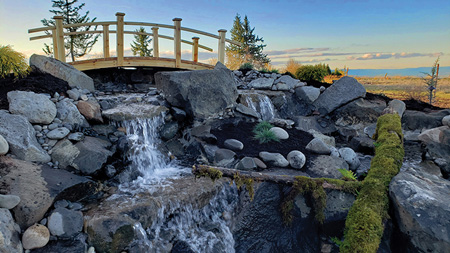Brad Steyskal & Jim Lewis, Lewis Landscape Services
When we first met our client at his new home at the summit of a mountain in rural Hillsboro, Oregon, two things stood out — the size of his property and the prominence of the man who stood before us.
At 7 feet 1 inch tall, the former NBA player was just as striking as his new 6-acre property. With sweeping views in several directions, it was absolutely stunning. Our client and his wife wanted a landscape with features that matched that scale of the home and property. Chief among those features was the desire for a massive waterscape element. At 45 feet long and about 20 feet wide, it would be the largest water feature project our company had taken on to date.
We worked with our client to create an alpine water feature concept — something that might remind you of the Pacific Northwest, where waterfalls naturally cascade down the mountainsides. It would need plenty of native grasses (fescues, carex) as well as dwarf evergreen conifer trees native to the mountains in Oregon, such as mountain hemlocks and sub-alpine firs. The small and slow-growing nature of these trees helped to ensure they wouldn’t outgrow the water feature over time.
Our first challenge was designing a waterfall that didn’t look like it had been designed. Water would need to flow naturally and unpredictably. While we would have to generally direct and channel the water, we still let the water flow where it wanted to in order to achieve the natural look we were after.
There were originally only eight planned waterfalls. The additional waterfalls came about only after we had completed much of the construction and turned on the water for the first time. We allowed the water to flow naturally before we began to mortar in certain areas to direct the flow, keeping the water somewhat contained and maximizing the flow to the desired areas.
Allowing the water to dictate the look was key. If you look carefully at the feature, there are numerous spillways, falls and streams that naturally formed between the main waterfalls that we originally planned. After the feature had been installed for a few weeks, our client commented that every time he walked around and examined the feature, he noticed something new that he hadn’t recognized before.
Once the natural flow of water was identified, it was fairly easy to tweak certain elements and still achieve the natural mountainside waterfall look we were after.
Another other key design consideration was the fact that the client’s grandchildren would likely interact with the water feature. Though it wasn’t specifically designed with special filters or a UV filtration system for recreation, the waterscape would probably be irresistible to any little ones tempted to play in and around the water feature. Special care was taken to minimize pond depth and ease off access to the pond.
As an example, the main entrance to the pond is gently sloped — the way you might find the pool at a resort, with a sandy beach that slowly spills into the water. The feature was designed with special boulder placement and added stabilization measures (i.e., many were mortared into place) to ensure that children could play in and around the water feature and really enjoy it from many different vantage points. Splashing around in the 2-foot-deep, river-rock-lined pond, playing around the spillways and retention pond, and climbing on the boulders around the perimeter and within the waterfalls are all made possible, with relative safety.
Construction Challenges
This was not your typical water feature. After a lot of calculation, we realized we would need a very large pump. We ended up using a pump that was a full 1 Horsepower and rated at 183 gallons per minute (at 8 feet of head) with a 4-inch feed. It has a constant 11-amp draw, so the usual 15-amp circuit wouldn’t cut it. We had the electrician run a 20-amp dedicated circuit out into the landscape to an area near where the pump is located.
Another challenge was the pond liner. We had to custom order a 30-by-60-foot, 45-mil EPDM pond liner, which is ridiculously heavy if you’ve never tried to move such a monster. Thankfully, a large excavator and several hardworking crew members helped us move it into place.
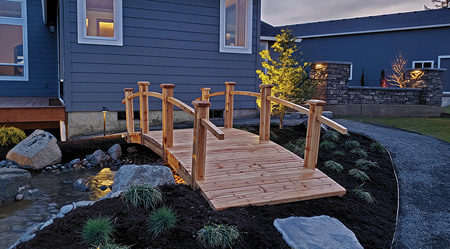
Boulder placement was also a challenge. In the past, we hadn’t always needed big equipment to place boulders, but these were massive and certainly needed an excavator. Fortunately, we have a good friend who owns an excavation company and helped us with this oversized task. The large excavators ended up really saving the day. Still, we did not want to rush this key part of the process. We spent two full days with our excavator, carefully trying out boulders in different areas and positions until we achieved exactly the look we had envisioned.
Among other construction challenges were the installation of a drip tube inside the pockets of planting within the waterfalls and the installation of outdoor lighting wire and fixtures in those same areas. For the lighting, we specifically chose Integrated LED fixtures from Kichler due to their extreme water resistance. These fixtures are fully potted so that water and moisture cannot reach the light array or the electronic components. This avoids the fatal flaw of many outdoor light fixtures sited around water.
In perhaps the biggest challenge of them all, this project was completed over the winter months. Thankfully, in the Portland, Oregon area, we can generally work year-round, as it doesn’t snow or freeze much in the valley. However, as this project was on a mountaintop in the country, we actually did encounter snow, ice and a lot of rain. At one point in January, Brad went to check on the project and sunk into mud past his knees due to all the rain we had been getting.
Finishing Touches
Once the main construction was completed, we brought in some additional elements you might expect to see in a natural mountainside waterfall. Fortunately, part of our client’s property was a forest, so we were able to bring in some fallen mossy branches and boulders to help us out. This was a trick we learned from previous water feature builds. We tried to integrate into the feature as many natural elements as possible from the property and surrounding landscape. Little touches like this make a huge difference.
In addition to the natural elements we brought in, we also wanted to create areas close by that would allow people to enjoy it from every angle. The elevated deck above the water feature provides a full panoramic view of the feature from top to bottom. We also built a lower paver patio that blends into the side of the water feature. The compact gravel area at the front of the pond allows people to sit at the bottom to take in its entirety, all while congregating around a campfire or enjoying the sounds of nature in the swinging chair and fire ring that our client installed after we were done with construction.
One of the most prominent elements of this project is a wooden foot bridge that spans the very top of the waterfalls. We’ve built similar structures like this in the past, and as is often the case, it was a big hit. It’s as functional as it is beautiful.
When you’re taking on a project of a larger scale than ever before, one of the biggest pitfalls can be failing to consider every single thing you might need to finish the job. Without enough experience, it can be easy to overlook materials, labor and other costs (like electrical). Fortunately, we spent a lot of time carefully thinking through all the necessary steps to build this water feature. To help make sure we had accounted for everything, we made sure to meet with our excavator before we gave the client our quote. We also worked with our water feature expert at Ewing to make sure we had sized the right pump and selected all the right materials. We budgeted enough money for labor so that we could take our time and do it right. In the end, it was both a beautiful water feature and a profitable endeavor for our company — which is always the goal, right?
Both of us enjoyed the challenge of creating this natural alpine water feature, and our clients were absolutely thrilled with it.
